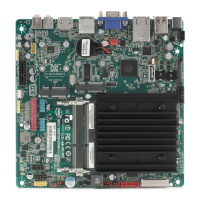Intel Desktop Board DN2800MT Technical Product Specification
26
• Custom EDID payload installation for ultimate parameter flexibility, allowing
custom definition of EDID data on panels without onboard EDID
In addition, BIOS setup provides the following configuration parameters for internal
flat panel displays:
• Screen Brightness: allows the end user to set the screen brightness for the display
effective through the Power-On Self Test stage (such as while showing the splash
screen image and BIOS setup). Windows 7 will ignore this setting in favor of the
native “screen brightness” control provided by the operating system.
• Flat Panel Configuration Changes Lock: allows the system integrator to “lock”
critical settings of the LVDS configuration to avoid end users potentially rendering
the display unusable.
• Brightness Steps: allows the system integrator to configure the brightness steps
for the operating system’s “screen brightness” control (such as the “Screen
brightness” adjustment slider under the Windows 7 “Power Options” control panel).
• LVDS Interface Type: allows the system integrator to select whether the LVDS
panel is a single-channel or dual-channel display.
• Swap LVDS Channels 0/1: allows the system integrator to swap the EVEN/ODD
LVDS channel assignments shall the cable be wired opposite the panel pinout.
• Color Depth: allows the system integrator to select whether the panel is 24 bpp
with VESA color mapping (eDP and LVDS), 24 bpp with JEIDA color mapping (LVDS
only), or 18 bpp (eDP and LVDS).
• eDP Interface Type: allows the system integrator to select whether the eDP panel
is a 1-lane, 2-lane, or 4-lane display.
• eDP Data Rate: allows the system integrator to select whether the eDP panel runs
at 1.62 Gb/s or 2.7 Gb/s.
• Inverter Frequency and Polarity: allows the system integrator to set the operating
frequency and polarity of the panel inverter board.
• Maximum and Minimum Inverter Current Limit (%): allows the system integrator
to set maximum PWM%, as appropriate, according to the power requirements of
the internal flat panel display and the selected inverter board.
• Panel Power Sequencing: allows the system integrator to adjust panel sequencing
parameters, if necessary.
• LVDS Spread Spectrum Control: allows the system integrator to adjust spread
spectrum for the LVDS interface.
NOTE
Support for flat panel display configuration complies with the following:
1. Internal flat panel display connectivity is disabled (and all parameters hidden) by
default.
2. Internal flat panel display settings are not exposed through Intel
®
Integrator
Toolkit or Intel
®
Integrator Assistant GUIs.
3. Internal flat panel display settings will not be overwritten by loading BIOS setup
defaults.
4. Internal flat panel display settings will be preserved across BIOS updates.

